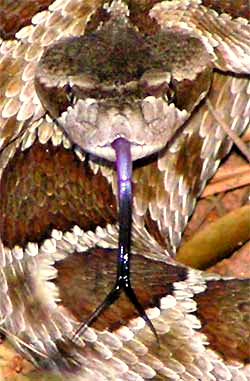 Photo by Andre Sage of Nevada
Photo by Andre Sage of NevadaStill, that does not mean that if you see a snake you should feel free to try to catch it. In many places it conceivably could be poisonous, and even non-poisonous snakes can bite. Besides, it's very upsetting to any wild creature to be caught.
It's a shame that people often react so hysterically toward snakes, for these creatures are to be appreciated -- not only because of their usefulness in controlling rodent populations but also because they are such streamlined, exquisitely adapted, beautiful and interesting organisms.
To get you started on discovering the snakes in your own neighborhood, here are our special pages:
- Classification of North American Snakes
- Snake Adaptations
- Tricks for Identifying Snakes
- Venomous Snakes in North America
- Listing Your Local Snakes
These other websites may be of interest to you, too:
- Snakes of N. America
- Florida Snake ID Guide
- Snakes of Kentucky
- Snakes of Massachusetts
- Snakes of Virginia
- Snakes of SE Queensland, Australia
- Care of Snakes
NOTE: Something is happening in the US today attracting venomous snakes to certain populated areas. The following is a comment from a policewoman in Tennessee:
We get many more calls about snakes in populated areas than we once did. The immediate reasoning given for this is that we are encroaching on snakes' territory. This is certainly true, but additionally I think we are attracting them. The increase in calls about snakes increased about the time that companies began using large piles of mulch around complexes. Mulch is, of course, warm, moist and can easily be burrowed. It seems to be the perfect habitat for snakes. So, I personally believe we're drawing the snakes into residential areas by piling up the perfect habitat for them.
Jim's note: That mulch also attracts rodents, which attracts snakes. But it still works out to more venomous snakes entering populated areas than they used to.
